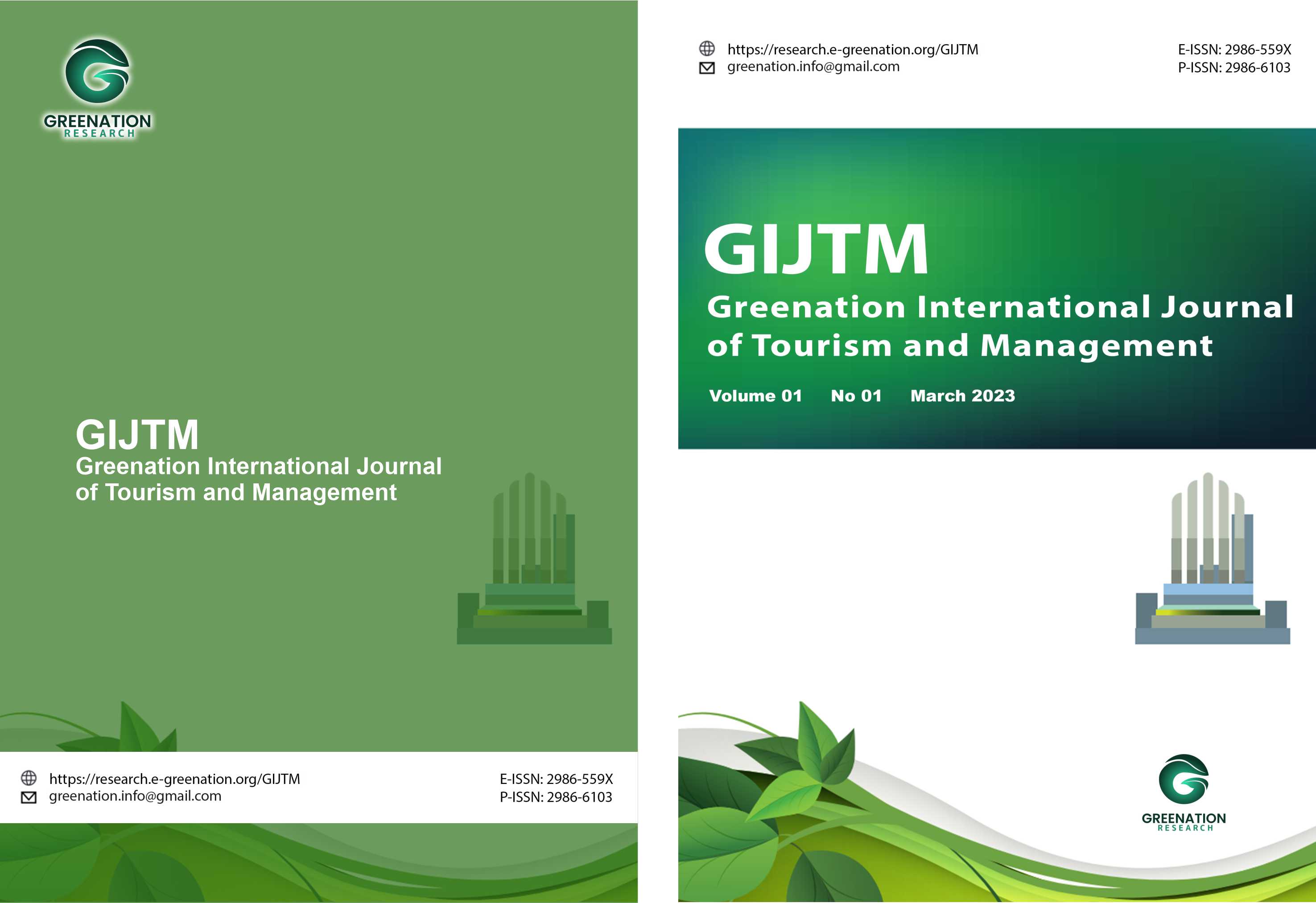Reimagining Indonesia's Culinary Tourism: The Power of Gastronomy and Branding
DOI:
https://doi.org/10.38035/gijtm.v3i2.329Keywords:
Culinary tourism, Gastronomy, Branding, Food Tourism, Sustainable TourismAbstract
Indonesia, with its rich cultural heritage and diverse culinary traditions, offers a unique opportunity for the development of culinary tourism. The integration of gastronomy and branding plays a pivotal role in enhancing Indonesia’s appeal as a prime destination for food enthusiasts. This paper explores the synergy between gastronomy and tourism branding in Indonesia, emphasizing how culinary experiences can be marketed to attract both domestic and international tourists. By focusing on the authenticity, variety, and distinctiveness of Indonesian food, tourism stakeholders can craft compelling narratives that highlight the country's diverse culinary offerings. The study also examines successful branding strategies implemented in other countries, which Indonesia can adapt to position itself as a global culinary hub. Additionally, the role of local communities, chefs, and food producers in preserving traditional flavors and cooking techniques is discussed as a crucial element in building a strong culinary identity. Through effective branding, Indonesia’s culinary tourism can not only increase the country's tourism revenue but also promote sustainable practices that benefit local economies and cultures. The findings suggest that Indonesia has the potential to become a leading culinary destination, provided there is a strategic, well-coordinated effort to combine gastronomy with tourism branding.
References
Bui, M., & Sweeney, J. C. (2009). The influence of food and beverage services on tourism. International Journal of Contemporary Hospitality Management, 21(7), 1-16
Chien, P. M. (2013). Tourism branding: A critical review of research in the last decade. Journal of Hospitality & Tourism Research, 37(1), 10-33.
Everett, S. (2009). Food and tourism: An effective partnership? Tourism Management, 30(4), 453-457.
Everett, S. (2009). Food and tourism: An overview of the state of the art. Tourism Management, 30(4), 637-653. https://doi.org/10.1016/j.tourman.2008.10.010
Getz, D. (2000). Explore wine tourism: Management, development and destinations. CABI Publishing.
Gössling, S. (2002). Global environmental consequences of tourism. Global Environmental Change, 12(4), 283-290. https://doi.org/10.1016/S0959-3780(02)00033-9
Hall, C. M., & Sharples, L. (2003). The consumption of experiences or the experience of consumption? An introduction to the special issue on the consumption of tourism. Tourism Management, 24(5), 453-464. https://doi.org/10.1016/S0261-5177(03)00009-3
Hall, C. M., & Sharples, L. (2003). The consumption of experiences or the experience of consumption? An introduction to the tourism of food. In Food Tourism around the World: Development, Management, and Markets. Routledge.
Henderson, J. C. (2009). Food tourism reviewed. British Food Journal, 111(4), 317-326. https://doi.org/10.1108/00070700910951916
Hjalager, A. M. (2002). A typology of gastronomy tourism. Tourism, 50(3), 234-246.
Iglesias, O., Singh, J. J., & Batista, P. (2011). The role of brand credibility in the development of consumer trust in tourism brands. Journal of Brand Management, 18(7), 429-442.
Kivela, J., & Crotts, J. C. (2006). Tourism and gastronomy: A review of the literature. Tourism Management, 27(5), 638-648.
Kivela, J., & Crotts, J. C. (2006). Tourism and gastronomy: Gastronomy’s influence on how tourists experience a destination. Journal of Hospitality & Tourism Research, 30(3), 354-377. https://doi.org/10.1177/1096348006286797
Kotler, P., Bowen, J., & Makens, J. (2017). Marketing for hospitality and tourism (7th ed.). Pearson Education.
Kotler, P., & Keller, K. L. (2016). Marketing management. (15th ed.). Pearson Education.
Kotler, P., Haider, D. H., & Rein, I. (2017). Marketing places: Attracting investment, industry, and tourism to cities, states, and nations. Free Press.
Liu, Z. (2009). A study of culinary tourism. Tourism, 57(2), 169-187.
McKercher, B., & Du Cros, H. (2002). Cultural tourism: The partnership between tourism and cultural heritage management. Haworth Hospitality Press.
Michelli, J. A., & Schmitt, B. H. (2015). Branding in food tourism. Routledge.
Michelli, J. A., & Schmitt, B. H. (2015). Customer experience management: A critical review and research agenda. International Journal of Service Management, 23(1), 10-22. https://doi.org/10.1108/IJSM-07-2014-0175
Nuryanti, W. (1996). Heritage and postmodern tourism. Annals of Tourism Research, 23(2), 249-260.
Palmer, A. (2010). Principles of services marketing. (6th ed.). McGraw-Hill.
Pappu, R., Quester, P. G., & Cooksey, R. W. (2007). Consumer perceptions of brand equity and brand image: The case of the Australian wine industry. Journal of Brand Management, 14(6), 432-448.
Pine, B. J., & Gilmore, J. H. (1999). The experience economy: Work is theatre & every business a stage. Harvard Business Press.
Richards, G. (2002). Gastronomy: An essential ingredient in tourism production and consumption? Tourism Recreation Research, 27(2), 85-90. https://doi.org/10.1080/02508281.2002.11081279
Sundari, A. (2016). Indonesian culinary tourism: An analysis of tourism opportunities through gastronomy. Tourism Studies, 8(2), 33-45.
Suaidy, Soehardi, Winarso, W., Syarif, F., & Untari, D. T. (2021). Supplier Selection Of 40th Container In PT Tribudhi Pelita Indonesia Using Analytical Hierarchy Process (AHP) Method. Academy Of Strategic Management Journal, 20(2).
Untari, D. T. (2019). Manajemen Pemasaran: Kasus Dalam Pengembangkan Pasar Wisata Kuliner Tradisional Betawi. Pena Persada.
Untari, D. T., Darusman, D., Prihatno, J., & Arief, H. (2018). Strategi Pengembangan Kuliner Tradisional Betawi Di DKI Jakarta. EKUITAS (Jurnal Ekonomi Dan Keuangan), 2(3). https://doi.org/https://doi.org/10.24034/j25485024.y2018.v2.i3.4011
Untari, D. T., & Satria, B. (2021). Integration of Supply Chain Management to Business Performance and Business Competitiveness of Food Micro Industry. Uncertain Supply Chain Management, 9(3), 705–710. https://doi.org/10.5267/j.uscm.2021.4.008
Downloads
Published
How to Cite
Issue
Section
License
Copyright (c) 2024 Dhian Tyas Untari, Budi Satria

This work is licensed under a Creative Commons Attribution 4.0 International License.
Copyright :
Authors who publish their manuscripts in this journal agree to the following conditions:
- Copyright in each article belongs to the author.
- The author acknowledges that the Greenation International Journal of Tourism and Management (GIJTM) has the right to be the first to publish under a Creative Commons Attribution 4.0 International license (Attribution 4.0 International CC BY 4.0).
- Authors can submit articles separately, arrange the non-exclusive distribution of manuscripts that have been published in this journal to other versions (for example, sent to the author's institutional repository, publication in a book, etc.), by acknowledging that the manuscript has been published for the first time at GIJTM.


























